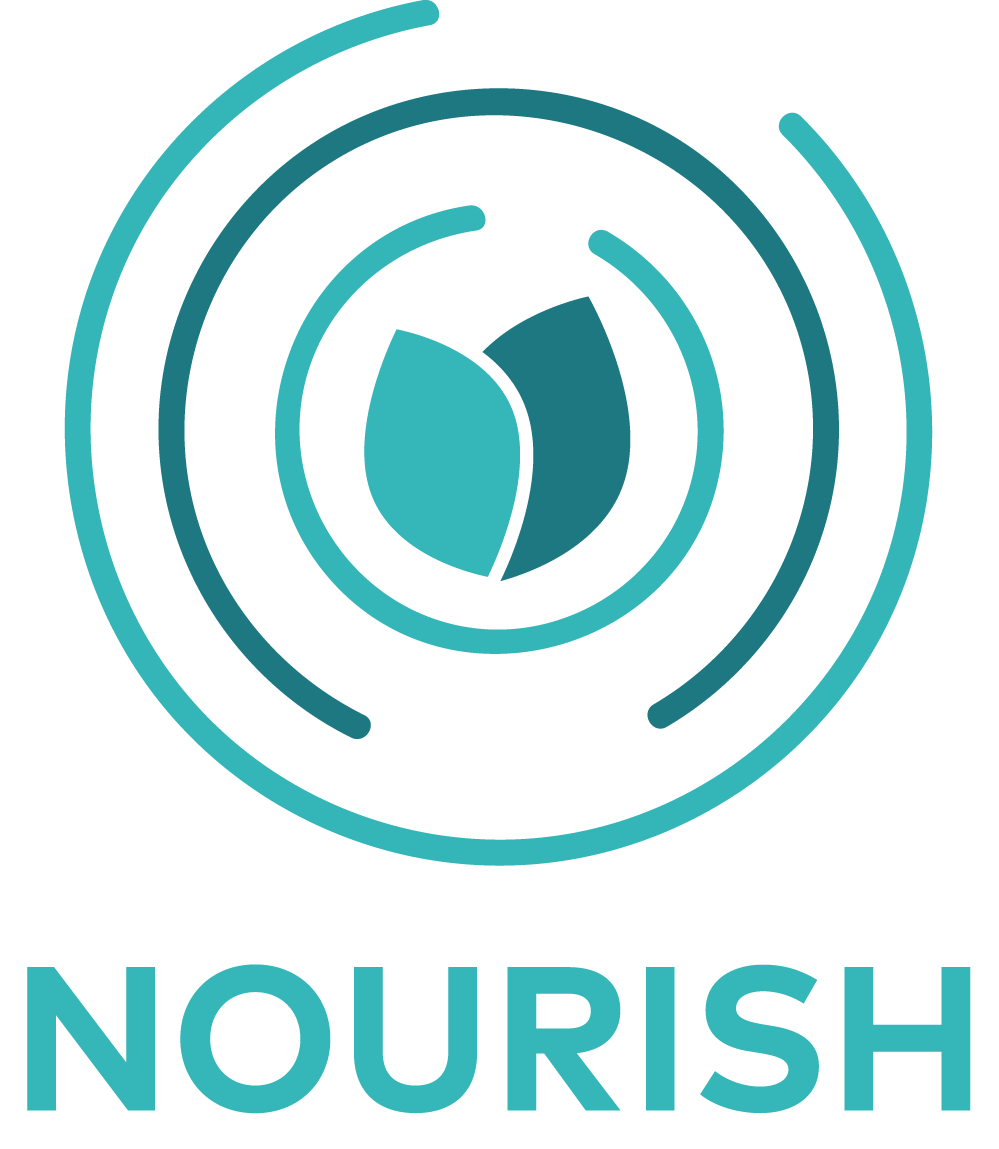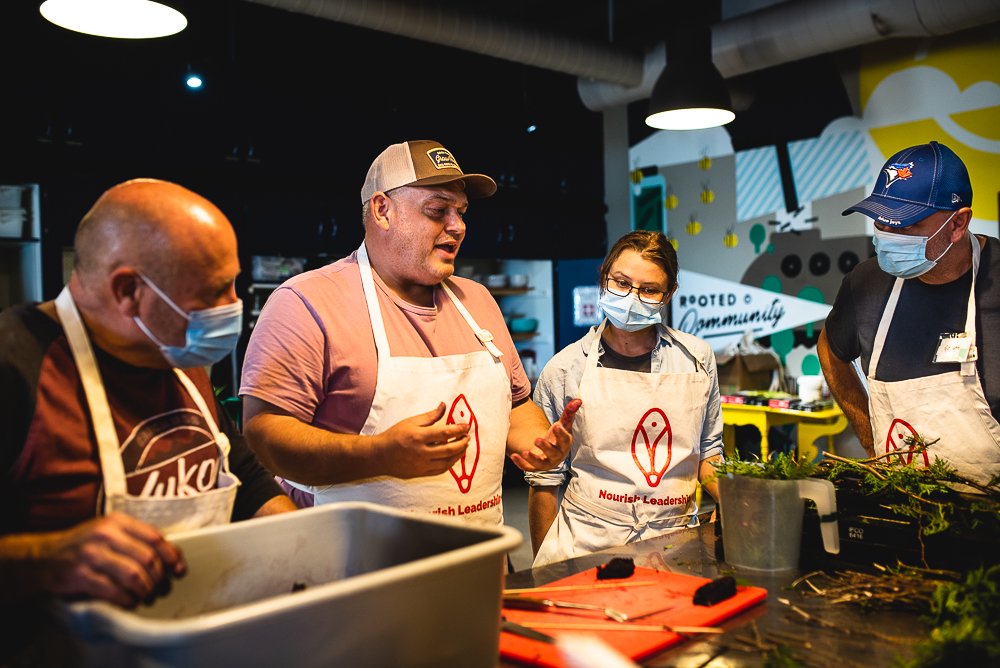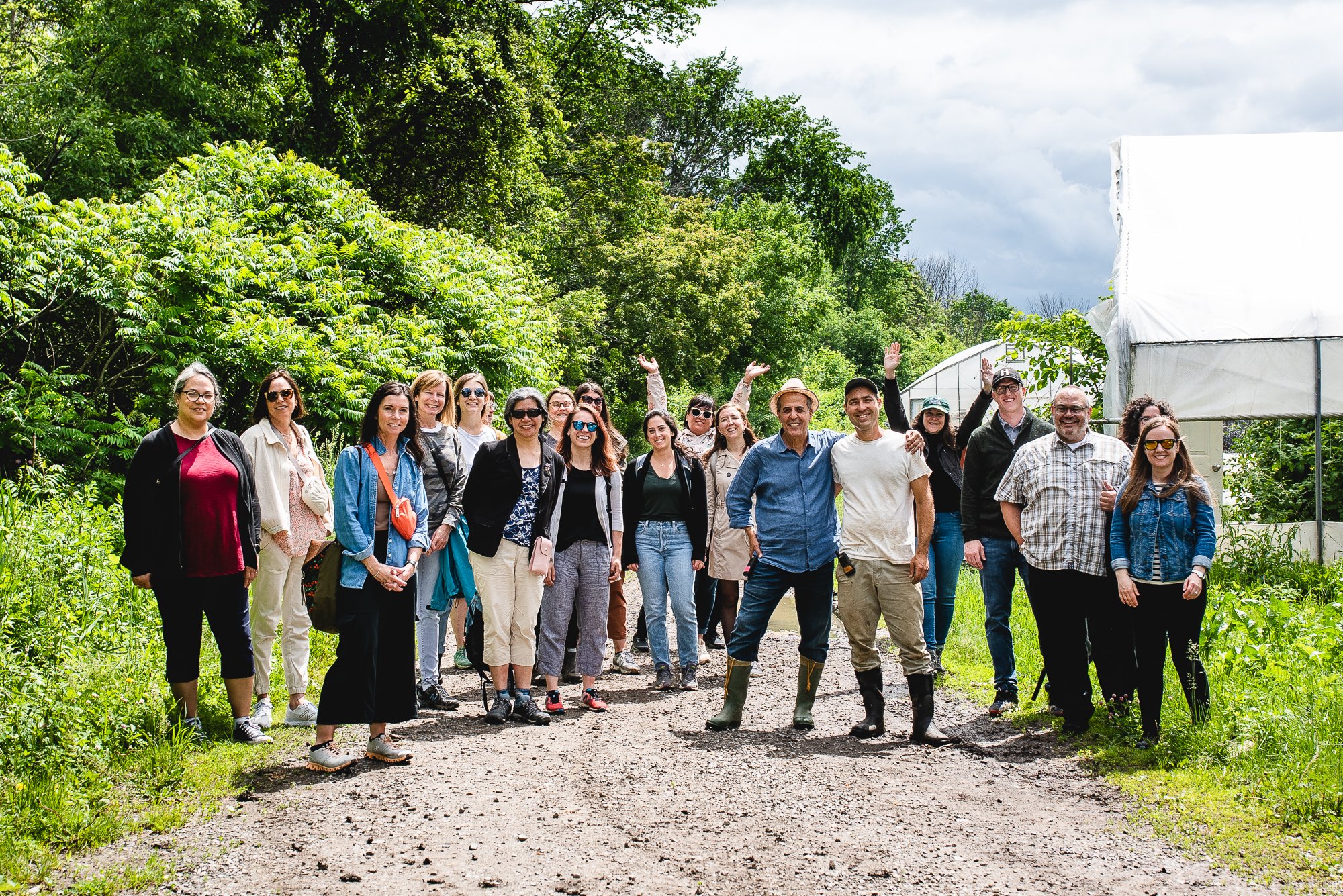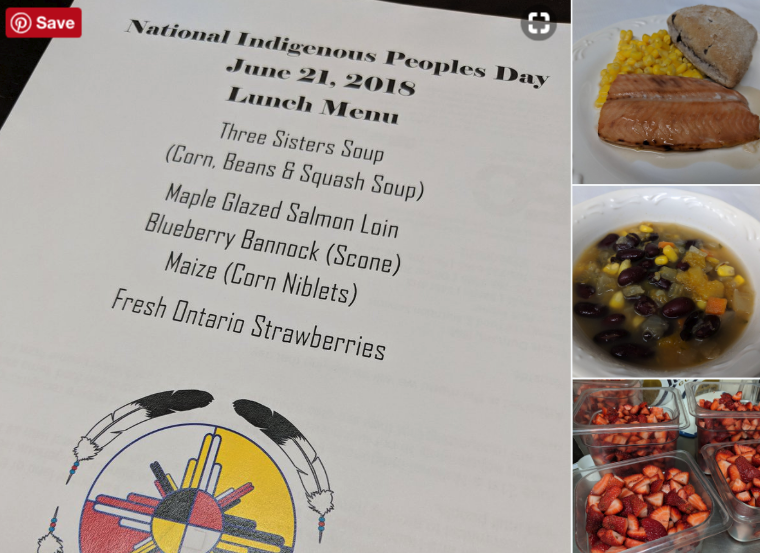How do we connect the health of people with the health of the planet through food? Nourish held a two-day symposium at Evergreen Brickworks in Toronto, gathering over 170 people from the health care and food sectors to learn about how health care can take leadership in making food a fundamental part of health and healing. Read our highlights from the event.
Launch of Nourish Documentary "Miichim"
We are proud to launch the short documentary"Miichim", which is about Kathy Loon and her team at Sioux Lookout MenoYaWin Health Centre (SLMHC) in Northwestern Ontario and their dedication to serving traditional foods to their Indigenous patients for health and healing.
How can dietitians learn from Indigenous food ways?
Kelly Gordon is a Nourish innovator and is a Registered Dietitian currently working with the Six Nations of the Grand River. Kelly is Kanyen’keha (Mohawk), bear clan and a proud mother of two energetic children. Her current focus is working to integrate Traditional knowledge into her everyday practice, supporting community members on their journey towards wellness.
“As health care providers, we need to address the social, emotional, mental and spiritual dimensions of the relationship that people have with food.
”
When most dietitians advocate for the role of food in health and healing, we emphasize the physical and nutritional impact it has on our bodies. However, as health care providers, we need to address the social, emotional, mental and spiritual dimensions of the relationship that people have with food.
I have been working as a registered dietitian for 15 years and as an regulated health provider, I choose to weave these dimensions into my dietetic practice. At Six Nations Health Services, I work to improve the community members’ relationships with food. When people are instructed that they need to choose ‘healthier fats’ or have to ‘eat smaller carbohydrate portions’, it can be irrelevant when they may present as food insecure or have been impacted by trauma. For me, it is about listening to and understanding them so that I can draw from their experiences to expand their relationship with food. This can be the starting point to highlight the kind of positive behaviour change that can co-exist with their needs.
My personal journey developed during my bachelors of science from the Nutrition and Dietetics program at McGill University. I ended up doing a work study placement at the Centre for Indigenous Nutrition and Environment (CINE) where they connected me with other Indigenous dietitians. My university years were deeply formative to me in connecting more deeply with my own Mohawk roots and learning about the importance of food in community health. However, the impacts of community health and food insecurity are not discussed enough at school. We didn’t talk about the environmental impact of how food is grown, or the relationship between food and land. This may be the reason why dietitians are prone to work in more clinical settings instead of working in community health, because we’re trained to see ourselves most fitting into a clinical environment.
With dietitians, this leads to an underlying expectation around the judgemental responses people anticipate us to give. I’m often sitting around people who exclaim “don’t look at what I’m eating, it’s not good!” when they find out I’m a dietitian. When people say things like that, I think about what their connection is with their food that triggers this fear of judgement. I also consider the kind of food and healthcare culture we have that reinforces this shame and stigma when it comes to what we eat.
As dietitians, we need to learn that we’re not just here to fix a ‘problem’. This is a colonial mindset in healthcare that is challenging to overcome. Our mandate to provide safe and reliable health information is inherently biased around a particular set of criteria that determines what is evidence-based and quantifiable. Why do we overlook Indigenous wisdom derived from generations of community-based and historical knowledge?
“A lot of my learning comes from my interactions with the Six Nations community and following the direction and voices of Indigenous community members. As a dietitian, I don’t come in claiming to be an expert, but as a person who will listen, learn and support.”
We need to learn how to shift the current perception around the dietitian’s role, and the role of the health care provider overall. This means moving away from dominant western biomedical care practices and establishing a model of care rooted within Indigenous practices and food ways. It is crediting Indigenous wisdom as reliable and trustworthy information. A lot of my learning comes from my interactions with the Six Nations community and following the direction and voices of Indigenous community members. As a dietitian, I don’t come in claiming to be an expert, but as a person who will listen, learn and support.
We need to learn that even the term “healthy food” should be challenged. The idea of “healthy” foods has become limiting and is causing shame around what people should or should not eat. There is a role for Indigenous knowledge to inform a more holistic understanding around what is nourishing food, and to enable us to re-examine people’s emotional, cultural and spiritual connections to food, as well as food’s connection to land and the greater environment.
The way that we eat is a massive contributor to the environment beyond our physical selves. If we look at the ways that our ancestors have nourished their whole selves by eating the foods that grew in their local regions, and by eating in amounts that allow all to eat, we find practices embedded in the Seventh Generation teachings. How we eat and practice in our daily lives should be mindful of what the world should look like seven generations from now. Our teaching around food and foodways shifts us to being more mindful about the good energy we pour into how we obtain and prepare our foods, and to being thankful for our food and who prepared it. This allows us to cultivate a more meaningful and mindful relationship with food that nourishes our bodies, minds and spirits.
“Self-awareness and understanding has to go hand-in-hand with the actions taken for true reconciliation to happen.”
This kind of mindful work takes a lot of time and effort and it can’t be done quickly. Right now, I’m working with a team of dietitians and food service professionals from across the country on a project where we want health care organizations to acknowledge and provide Indigenous and Country foods. However, choosing to source and serve Indigenous foods cannot just be a checkbox. It needs to be about stepping back and gaining more self-awareness around why it is so valuable and important to include traditional foods and food ways. Self-awareness and understanding has to go hand-in-hand with the actions taken for true reconciliation to happen.
Myself and fellow Nourish innovator Shelly Crack at the Reconciliation Totem Pole in British Columbia.
Recently, I presented at the Dieticians of Canada conference in Vancouver and visited the Reconciliation Totem Pole at the University of British Columbia with fellow Nourish Innovator Shelly Crack. This beautiful structure created by a Haida artist symbolizes a violent and brutal break in Indigenous culture with residential schools. This made me reflect on how like a bone, when culture is broken, it may never function the same way. However, the more important question is the one around healing -- when something breaks, what kind of physical, emotional and spiritual rehabilitation is required to nourish and build up strength again? I believe that food is a great way to nourish, but it is also a critical part of starting and continuing these kinds of difficult conversations.
Travis Celebrates Indigenous Peoples Day at Grove Park with a Traditional Menu
June 21 marked National Indigenous Peoples Day, and to celebrate and honour the day, Travis brought Huron-Wendat and Anishinabek dishes to the Grove Park Home menu. We interviewed Travis to learn how it all came about and to hear his takeaways from the day.
What got you thinking about Indigenous food in care?
I never really considered Indigenous food in healthcare prior to becoming a member of the Nourish cohort. After learning more about traditional foods from other cohort members, I realized that there is a lot that needs to be done to promote Indigenous foods in Canada and to educate the public.
Why does it matter to you?
It was important to recognize Huron-Wendat and Anishinabek people. The area is rich in their history, and I believe it was an opportunity to share their culture and cuisine with our residents, families and employees.
“I did some research on the Huron-Wendat and Anishinabek foods, and spoke with a family member who is actively engaged in sharing Indigenous traditions.”
Tell us about your process to create a new menu for this day.
Initially, I reached out to Kathy Loon and Kelly Gordon, as well as Hayley Lapalme who provided me with some feedback on menu creation. That gave me a good baseline to develop the menu. Then I did some research on the Huron-Wendat and Anishinabek foods, and spoke with a family member who is actively engaged in sharing Indigenous traditions.
What's on the menu and how did you develop it? Where did you source the food?
The menu consisted of Three Sisters Soup, we used a recipe sourced online. We were originally going to serve a maple glazed trout but had difficulty sourcing a suitable cost-effective product, so we went with salmon. From there it was accompanied with blueberry bannock (which was a commercially sourced tea biscuit), maize (corn) and for dessert was fresh strawberries, sourced locally.
How was the menu received?
The menu was received quite well, and the promotion of Indigenous Peoples day engaged our staff to discuss further. We had the adult day program staff even prepare a First Nations treat consisting of warm apple slices, cranberry and berries.
What reactions did residents give? What about staff?
We have a small contingent of Indigenous residents, but the most popular menu item was the Three Sisters Soup. We had numerous staff thank us for doing something to recognize the Indigenous population. It was well received.
Will you do it again? Same or different?
I would absolutely do it again. I didn't give myself enough time to source product. In the future, I would get in touch with a local Native Friendship Centre or one of the many reservations close by to source better recipes and menu item options. It can be difficult to develop a menu in long-term care that is appropriate for an ailing population that we serve.
“I would absolutely do it again. A few suggestions for others: connect with your local Native Friendship Centre, traditional food specialists, and even the clientele that you serve.”
What advice do you have for others who are thinking of bringing traditional foods into their own menu?
A few suggestions for others, as said above: connect with your local Native Friendship Centre, traditional food specialists, and even clientele that you serve. Do research on the items you are serving so that you can educate the people you're serving. Have fun sharing and learning!
Thank you Travis!
Patients and staff enjoy traditional foods at Saskatchewan Health Authority Regina on National Indigenous Peoples Day
To celebrate National Indigenous Peoples Day on June 21, Stephanie and her food and nutrition staff at Saskatchewan Health Authority facilities in Regina served up delicious traditional dishes to both staff and patients. We interviewed Stephanie to learn about how she and her team planned this menu and what inspired her.
What got you thinking about Indigenous food in care?
Nourish! It was the collective knowledge and the passion of my Nourish colleagues that inspired me to start thinking about how I could incorporate more traditional foods into the menus where I work. I had a moment around the Colton Boushie trial where I thought to myself, ‘If everyone did one small thing to move this forward, we could change things.’ And then I realized, ‘Well, what am I doing?’ So I decided to dedicate a large portion of our new Wellness Garden to Truth and Reconciliation, where we will grow traditional medicinal plants in partnership with local First Nations communities and Elders. Doing this menu was another step we could take to put our learning into practice.
Why does it matter to you?
It matters because many of the people in our care have Indigenous roots and sadly this has been largely overlooked in our menu planning. I believe that every person has the capacity to contribute in a positive way to truth and reconciliation.
Nutrition and Food Services employee, Lee Bannister, dishing up the bison stew for patients at the Regina General Hospital in celebration of National Indigenous Peoples Day!
What's on the menu and how did you develop it? Where did you source the food?
At our Nourish retreat in April, my group had the good fortune to visit the Squamish Lil'wat Cultural Centre in Whistler as a part of our learning journeys, and have lunch from their café. I had the most amazing salmon sandwich on bannock and wondered if it was something we could do in our cafeterias here in Regina. I described it to one of my Food Services Managers (Garnet Roberts), who is also an amazing chef, who said “no problem.” Garnet used Traditional Foods and Recipes from the Wild Side, a publication by the Native Women’s Association of Canada as a resource for recipes.
“Our Food Services Manager used ‘Traditional Foods and Recipes from the Wild Side,’ a publication by the Native Women’s Association of Canada as a resource for recipes.”
With National Indigenous Peoples Day on the horizon, we selected this day for its debut and learned to create a recipe for salmon on bannock sandwich with arugula and a juniper dill aioli. Using bison sourced locally from Saskatchewan, Garnet also prepared a dish of bison stew, served with corn and bannock to honour the day while also celebrating local ingredients. The stew was perfect as it could work with nearly all diet types (although we did have to relax our restrictions for sodium and fat). We served this meal across our four Regina sites to nearly all patients and residents and featured this item in the cafeteria as well. We lost count after 1000 servings! It was a big hit.
Joyce Wong serving up the salmon on bannock sandwich in the hospital cafeteria
What reactions did the residents give? What about staff?
There was a real buzz in our kitchens. Staff was excited about serving something new and different and we had never really done anything in celebration of National Indigenous Peoples Day before. Many of the staff tried the stew before we served it and they felt proud – proud of our department for making the day special for the people in our care and proud of themselves for being a part of it.
Will you do it again? Same or different?
We will absolutely do it again, but we will have to find a different recipe for next year. The bison stew and bannock was such a hit we are planning to add it into our regular menu rotation. As for the salmon sandwich, I’m pretty sure we will see it in our cafeterias again soon – it sold out too!
“The bison stew and bannock was such a hit we are planning to add it into our regular menu rotation.”
Paul Neiman, a cook at the Wascana Rehabilitation Centre (Regina) , proudly displays the salmon on bannock sandwich prepared in honour of National Indigenous Peoples Day. Wascana joined the Pasqua Hospital, the Regina General Hospital and Regina Pioneer Village in this celebration, serving more than 2000 servings of bison stew and salmon sandwiches to our patients, staff, and visitors.
What advice do you have for others who are thinking of bringing traditional foods into their own menu?
My advice to others is, especially if this is for a special occasion like National Indigenous Peoples Day, would be set aside your dietitian hat (or work with your dietitians) and relax your nutrient goals for the day. We decided we wanted something special for everyone, including our patients on more restrictive diets (like cardiac and renal), so they too could experience the meal as close to the ‘real thing’ as possible. We made a version with ground bison and veggies so even our folks on soft and minced diets could enjoy the same meal. We were so pleased to hear we got it right, with colleagues from Native Health Services sharing… “that was some top quality bannock today”.
Thank you Stephanie!















